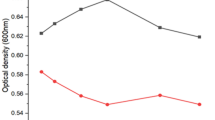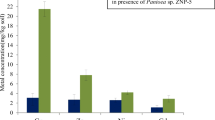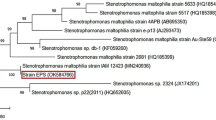Abstract
In modern agricultural practice, heavy metal (HM) contamination is one of the main abiotic stress threatening sustainable agriculture, crop productivity, and disturb natural soil microbiota. Different reclamation techniques are used to restore the contaminated site; however, they are either costly or unable to remove contaminant when concentration is very low. In such circumstances, bioremediation is used as a novel technique involving microbes for soil restoration. In the current project, Aspergillus welwitschiae(Bk) efficiently endure metal stress (i.e., Cr-VI and As-V in the form of K2Cr2O7 and Na3AsO4) up to 1200 μg/mL and enhanced the production of phytohormones, i.e., 54.83 μg/mL of indole acetic acid (IAA) compared to control 15.56 μg/mL, solubilized inorganic phosphate, and produced stress-related metabolites. The isolate Bk was able to enhance growth of soybean by showing higher root shoot length and fresh/dry weight under stress (p<0.05). Besides, the strain strengthened the antioxidant system of the host increasing enzymatic antioxidants, i.e., catalases (CAT) by 1.58 and 1.11 fold, ascorbic acid oxidase (AAO) by 6.75 and 7.94 fold, peroxidase activity (POD) by 1.12 and 1.37 fold, and 1,1-diphenyl-2-picrylhydrazyl (DPPH) by 1.42 and 1.25 fold at 50 μg/mL of chromate and arsenate. Thus, actively scavenging the reactive oxygen species (ROS) produced results in lower ROS accumulation and high ROS scavenging. On the other hand, the isolates cut down Cr and As uptake by approximately 50% at 50 μg/mL from the medium while bio-transforming it, thereby stabilizing it and assisting the host to resume normal growth, thus avoiding phytotoxicity. It is evident from the current study that A. welwitschiae may potentially be used as a bioremediating agent for reclamation of Cr- and As-contaminated soil.










Similar content being viewed by others
References
Acosta-Motos JR, Ortuño MF, Bernal-Vicente A, Diaz-Vivancos P, Sanchez-Blanco MJ, Hernandez JA (2017) Plant responses to salt stress: adaptive mechanisms. Agronomy 7(1):18
Ainsworth EA, Gillespie KM (2007) Estimation of total phenolic content and other oxidation substrates in plant tissues using Folin–Ciocalteu reagent. Nature protocols 2(4):875–877
Ashraf S, Ali Q, Zahir ZA, Ashraf S, Asghar HN (2019) Phytoremediation: environmentally sustainable way for reclamation of heavy metal polluted soils. Ecotoxicology and environmental safety 174:714–727
Ayele, A. and Y. G. Godeto (2021). "Bioremediation of chromium by microorganisms and its mechanisms related to functional groups." Journal of Chemistry 2021.
Benhiba L, Fouad MO, Essahibi A, Ghoulam C, Qaddoury A (2015) Arbuscular mycorrhizal symbiosis enhanced growth and antioxidant metabolism in date palm subjected to long-term drought. Trees 29(6):1725–1733
Byreddy AR, Gupta A, Barrow CJ, Puri M (2016) A quick colorimetric method for total lipid quantification in microalgae. Journal of microbiological methods 125:28–32
Chamam A, Sanguin H, Bellvert F, Meiffren G, Comte G, Wisniewski-Dyé F, Bertrand C, Prigent-Combaret C (2013) Plant secondary metabolite profiling evidences strain-dependent effect in the Azospirillum–Oryza sativa association. Phytochemistry 87:65–77
Chu J, Yao X, Zhang Z (2010) Responses of wheat seedlings to exogenous selenium supply under cold stress. Biological trace element research 136(3):355–363
Chun J, Lee J-H, Jung Y, Kim M, Kim S, Kim BK, Lim Y-W (2007) EzTaxon: a web-based tool for the identification of prokaryotes based on 16S ribosomal RNA gene sequences. International journal of systematic and evolutionary microbiology 57(10):2259–2261
Cornejo, P., A. Seguel, P. Aguilera, S. Meier, J. Larsen and F. Borie (2017). Arbuscular mycorrhizal fungi improve tolerance of agricultural plants to cope abiotic stress conditions. Plant-microbe interactions in agro-ecological perspectives, Springer: 55-80.
Dhal B, Abhilash, Pandey BD (2018) Mechanism elucidation and adsorbent characterization for removal of Cr(VI) by native fungal adsorbent. Sustainable Environment Research 28(6):289–297
Dixit, V. K., S. Misra, S. K. Mishra, N. Joshi and P. S. Chauhan (2021). "Rhizobacteria-Mediated Bioremediation: Insights and Future Perspectives." Soil Bioremediation: An Approach Towards Sustainable Technology: 193-211.
Dotaniya, M., C. Dotaniya, K. Kumar, R. Doutaniya, H. Meena, A. Shirale, M. Meena, V. Meena, R. Kumar and B. Meena (2020). "Type of soil pollutant and their degradation: methods and challenges."
Dubey A, Malla MA, Kumar A, Dayanandan S, Khan ML (2020) Plants endophytes: unveiling hidden agenda for bioprospecting toward sustainable agriculture. Critical Reviews in Biotechnology 40(8):1210–1231
Edelstein M, Ben-Hur M (2018) Heavy metals and metalloids: sources, risks and strategies to reduce their accumulation in horticultural crops. Scientia Horticulturae 234:431–444
Egamberdieva, D., S. Wirth and E. F. Abd-Allah (2018). Plant hormones as key regulators in plant-microbe interactions under salt stress. Plant Microbiome: Stress Response, Springer: 165-182.
El Far M, Taie HA (2009) Antioxidant activities, total anthocyanins, phenolics and flavonoids contents of some sweet potato genotypes under stress of different concentrations of sucrose and sorbitol. Australian Journal of Basic and Applied Sciences 3(4):3609–3616
Etesami H, Maheshwari DK (2018) Use of plant growth promoting rhizobacteria (PGPRs) with multiple plant growth promoting traits in stress agriculture: action mechanisms and future prospects. Ecotoxicology and environmental safety 156:225–246
Fan, C., J. Qian, Y. Yang, H. Sun, J. Song and Y. Fan (2021). "Green ceramsite production via calcination of chromium contaminated soil and the toxic Cr (VI) immobilization mechanisms." Journal of Cleaner Production: 128204.
Gong M, You X, Zhang Q (2015) Effects of Glomus intraradices on the growth and reactive oxygen metabolism of foxtail millet under drought. Annals of Microbiology 65(1):595–602
Goswami D, Vaghela H, Parmar S, Dhandhukia P, Thakker JN (2013) Plant growth promoting potentials of Pseudomonas spp. strain OG isolated from marine water. Journal of plant interactions 8(4):281–290
Hao L, Zhang Z, Hao B, Diao F, Zhang J, Bao Z, Guo W (2021) Arbuscular mycorrhizal fungi alter microbiome structure of rhizosphere soil to enhance maize tolerance to La. Ecotoxicology and Environmental Safety 212:111996
Hayat Q, Hayat S, Irfan M, Ahmad A (2010) Effect of exogenous salicylic acid under changing environment: a review. Environmental and experimental botany 68(1):14–25
Hayat S, Hayat Q, Alyemeni MN, Wani AS, Pichtel J, Ahmad A (2012) Role of proline under changing environments: a review. Plant Signaling and Behavior 7(11):1456–1466
Hrynkiewicz K, Złoch M, Kowalkowski T, Baum C, Buszewski B (2018) Efficiency of microbially assisted phytoremediation of heavy-metal contaminated soils. Environmental Reviews 26(3):316–332
Huseynova IM (2012) Photosynthetic characteristics and enzymatic antioxidant capacity of leaves from wheat cultivars exposed to drought. Biochimica et Biophysica Acta -Bioenergetics1817(8):1516–1523
Iglesias MJ, Terrile MC, Bartoli CG, D’Ippólito S, Casalongué CA (2010) Auxin signaling participates in the adaptative response against oxidative stress and salinity by interacting with redox metabolism in Arabidopsis. Plant molecular biology 74(3):215–222
Jobby R, Jha P, Yadav AK, Desai N (2018) Biosorption and biotransformation of hexavalent chromium [Cr (VI)]: a comprehensive review. Chemosphere 207:255–266
Joo JH, Yoo HJ, Hwang I, Lee JS, Nam KH, Bae YS (2005) Auxin-induced reactive oxygen species production requires the activation of phosphatidylinositol 3-kinase. FEBS letters 579(5):1243–1248
Kazi T, Jamali M, Kazi G, Arain M, Afridi H, Siddiqui AJA (2005) Evaluating the mobility of toxic metals in untreated industrial wastewater sludge using a BCR sequential extraction procedure and a leaching test. Analytical and bioanalytical chemistry 383(2):297–304
Khan, N., Asadullah and A. Bano (2019). Rhizobacteria and abiotic stress management. Plant Growth Promoting Rhizobacteria for Sustainable Stress Management : Volume 1: Rhizobacteria in Abiotic Stress Management. R. Z. Sayyed, N. K. Arora and M. S. Reddy. Singapore, Springer Singapore: 65-80.
Kirk JT, Allen RL (1965) Dependence of chloroplast pigment synthesis on protein synthesis: effect of actidione. Biochemical and Biophysical Research Communications 21(6):523–530
Kısa D, Elmastaş M, Öztürk L, Kayır Ö (2016) Responses of the phenolic compounds of Zea mays under heavy metal stress. Applied Biological Chemistry 59(6):813–820
Larone, D. H. (1987). Medically important fungi: a guide to identification, Citeseer.
Lee, N. M. (2020). Biotechnological Applications of Extremophilic Microorganisms, Walter de Gruyter GmbH & Co KG.
Lewis T, Nichols PD, McMeekin TA (2000) Evaluation of extraction methods for recovery of fatty acids from lipid-producing microheterotrophs. Journal of Microbiological Methods 43(2):107–116
Li H, Chen XW, Wong MH (2016) Arbuscular mycorrhizal fungi reduced the ratios of inorganic/organic arsenic in rice grains. Chemosphere 145:224–230
Li YL, Xin XM, Chang ZY, Shi RJ, Miao ZM, Ding J, Hao GP (2015) The endophytic fungi of Salvia miltiorrhiza Bge.f. alba are a potential source of natural antioxidants. Botanical Studies 56(1):5
Lowry OH, Rosebrough NJ, Farr AL, Randall RJ (1951) Protein measurement with the Folin phenol reagent. Journal of biological chemistry 193:265–275
Mahajan P, Kaushal J (2018) Role of phytoremediation in reducing cadmium toxicity in soil and water. Journal of toxicology 2018:1–16
Marin A, Masscheleyn P, Patrick W (1992) The influence of chemical form and concentration of arsenic on rice growth and tissue arsenic concentration. Plant and Soil 139(2):175–183
Meng G, Tian Y, Yang Y, Shi J (2016) Evaluation of DPPH free radical scavenging activity of various extracts of Ligularia fischeri in vitro: a case study of Shaanxi region. Indian Journal of Pharmaceutical Sciences 78(4):436–442
Mierziak J, Kostyn K, Kulma A (2014) Flavonoids as important molecules of plant interactions with the environment. Molecules 19(10):16240–16265
Mohammadkhani N, Heidari R (2008) Drought-induced accumulation of soluble sugars and proline in two maize varieties. World Applied Sciences Journal 3(3):448–453
Munné-Bosch S, Alegre L (2000) Changes in carotenoids, tocopherols and diterpenes during drought and recovery, and the biological significance of chlorophyll loss in Rosmarinus officinalis plants. Planta 210(6):925–931
Natasha, M. Shahid, S. Khalid, B. Murtaza, H. Anwar, A. H. Shah, A. Sardar, Z. Shabbir and N. K. Niazi (2020). "A critical analysis of wastewater use in agriculture and associated health risks in Pakistan." Environmental Geochemistry and Health.
Oberbacher MF, Vines HM (1963) Spectrophotometric assay of ascorbic acid oxidase. Nature 197:1203–1204
Oleńska E, Małek W, Wójcik M, Swiecicka I, Thijs S, Vangronsveld J (2020) Beneficial features of plant growth-promoting rhizobacteria for improving plant growth and health in challenging conditions: a methodical review. Science of the Total Environment 140682
Pahari, A., A. Pradhan, S. Nayak and B. Mishra (2017). Bacterial siderophore as a plant growth promoter. Microbial Biotechnology, Springer: 163-180.
Pandey, N., V. Chandrakar and S. Keshavkant (2018). Mitigating arsenic toxicity in plants: role of microbiota. Mechanisms of Arsenic Toxicity and Tolerance in Plants, Springer: 191-218.
Paponov IA, Paponov M, Teale W, Menges M, Chakrabortee S, Murray JA, Palme K (2008) Comprehensive transcriptome analysis of auxin responses in Arabidopsis. Molecular Plant 1(2):321–337
Park D, Yun Y-S, Jo JH, Park JM (2005) Mechanism of hexavalent chromium removal by dead fungal biomass of Aspergillus niger. Water Research 39(4):533–540
Parry C, Blonquist JM Jr, Bugbee B (2014) In situ measurement of leaf chlorophyll concentration: analysis of the optical/absolute relationship. Plant Cell Environment 37(11):2508–2520
Premono, M. E., A. Moawad and P. Vlek (1996). Effect of phosphate-solubilizing Pseudomonas putida on the growth of maize and its survival in the rhizosphere.
Pütter, J. (1974). Peroxidases. Methods of enzymatic analysis, Elsevier: 685-690.
Qadir M, Hussain A, Hamayun M, Shah M, Iqbal A, Husna, Murad W (2020) Phytohormones producing rhizobacterium alleviates chromium toxicity in Helianthus annuus L. by reducing chromate uptake and strengthening antioxidant system. Chemosphere 258:127386
Rahman Z, Singh VP (2019) The relative impact of toxic heavy metals (THMs)(arsenic (As), cadmium (Cd), chromium (Cr)(VI), mercury (Hg), and lead (Pb)) on the total environment: an overview. Environmental monitoring and assessment 191(7):1–21
Rana V, Ram S, Nehra K (2017) Review proline biosynthesis and its role in abiotic stress. International Journal of Agriculture Innovations and Research 6(3):2319–2473
Reddy S, Girisham S, Babu GN (2017) Applied Microbiology (agriculture, environmental, food and industrial microbiology). Publishers, Scientific
Riaz, M., M. Kamran, Y. Fang, Q. Wang, H. Cao, G. Yang, L. Deng, Y. Wang, Y. Zhou and I. Anastopoulos (2020). "Arbuscular mycorrhizal fungi-induced mitigation of heavy metal phytotoxicity in metal contaminated soils: a critical review." Journal of Hazardous Materials: 123919.
Rolland F, Baena-Gonzalez E, Sheen J (2006) Sugar sensing and signaling in plants: conserved and novel mechanisms. The Annual Review of Plant Biology 57:675–709
Rosa M, Prado C, Podazza G, Interdonato R, González JA, Hilal M, Prado FE (2009) Soluble sugars--metabolism, sensing and abiotic stress: a complex network in the life of plants. Plant Signaling and Behavior 4(5):388–393
Santander C, Aroca R, Ruiz-Lozano JM, Olave J, Cartes P, Borie F, Cornejo P (2017) Arbuscular mycorrhiza effects on plant performance under osmotic stress. Mycorrhiza 27(7):639–657
Schiavon, M. and M. Malagoli (2008). Role of sulfate and S-rich compounds in heavy metal tolerance and accumulation. Sulfur Assimilation and Abiotic Stress in Plants, Springer: 253-269.
Selmar D (2008) Potential of salt and drought stress to increase pharmaceutical significant secondary compounds in plants. Landbauforschung Volkenrode 58(1/2):139
Shugaba A, Buba F, Kolo B, Nok A, Ameh D, Lori J (2012) Uptake and reduction of hexavalent chromium by Aspergillus niger and Aspergillus parasiticus. Journal of Petroleum and Environmental Biotechnology 3(119):2
Stone JK, Polishook JD, White JF (2004) Endophytic fungi. Biodiversity of Fungi. Elsevier Academic Press, Burlington:241–270
Tamura K, Peterson D, Peterson N, Stecher G, Nei M, Kumar S (2011) MEGA5: molecular evolutionary genetics analysis using maximum likelihood, evolutionary distance, and maximum parsimony methods. Molecular biology and evolution 28(10):2731–2739
Tonin C, Vandenkoornhuyse P, Joner E, Straczek J, Leyval C (2001) Assessment of arbuscular mycorrhizal fungi diversity in the rhizosphere of Viola calaminaria and effect of these fungi on heavy metal uptake by clover. Mycorrhiza 10(4):161–168
Ucun H, Bayhan YK, Kaya Y (2008) Kinetic and thermodynamic studies of the biosorption of Cr (VI) by Pinus sylvestris Linn. Journal of Hazardous Materials 153(1-2):52–59
Ultra VU Jr, Tanaka S, Sakurai K, Iwasaki K (2007) Arbuscular mycorrhizal fungus (Glomus aggregatum) influences biotransformation of arsenic in the rhizosphere of sunflower (Helianthus annuus L.). Soil Science and Plant Nutrition 53(4):499–508
Vacheron J, Desbrosses G, Bouffaud M-L, Touraine B, Moënne-Loccoz Y, Muller D, Legendre L, Wisniewski-Dyé F, Prigent-Combaret C (2013) Plant growth-promoting rhizobacteria and root system functioning. Frontiers in plant science 4:356
Wang H, Wang W, Huang W, Xu H (2017) Effect of salicylic acid on the gene transcript and protein accumulation of flavonoid biosynthesis-related enzymes in Vitis vinifera cell suspension cultures. HortScience 52(12):1772–1779
Wang K, Ma J-Y, Li M-Y, Qin Y-S, Bao X-C, Wang C-C, Cui D-L, Xiang P, Ma LQ (2021) Mechanisms of Cd and Cu induced toxicity in human gastric epithelial cells: oxidative stress, cell cycle arrest and apoptosis. Science of The Total Environment 756:143951
Wang L, Hou D, Shen Z, Zhu J, Jia X, Ok YS, Tack FM, J. J. C. R. i. E. S. Rinklebe (2020) Field trials of phytomining and phytoremediation: a critical review of influencing factors and effects of additives. Critical Reviews in Environmental Science and Technology 50(24):2724–2774
Waqas, M., A. L. Khan, M. Kamran, M. Hamayun, S.-M. Kang, Y.-H. Kim and I.-J. Lee (2012). "Endophytic fungi produce gibberellins and indoleacetic acid and promotes host-plant growth during stress." 17(9): 10754-10773.
Warrier R, Paul M, Vineetha MJG (2013) Estimation of salicylic acid in Eucalyptus leaves using spectrophotometric methods. Genetics and plant physiology 3(1-2):90–97
Wood JL, Tang C, and Franks AE (2016) Microbial associated plant growth and heavy metal accumulation to improve phytoextraction of contaminated soils. Soil Biology and Biochemistry 103:131–137
Wu, Q.-S. and Y.-N. Zou (2017). Arbuscular mycorrhizal fungi and tolerance of drought stress in plants. Arbuscular mycorrhizas and stress tolerance of plants, Springer: 25-41.
Xia S, Song Z, Jeyakumar P, Shaheen SM, Rinklebe J, Ok YS, Bolan N, Wang H (2019) A critical review on bioremediation technologies for Cr(VI)-contaminated soils and wastewater. Critical Reviews in Environmental Science and Technology 49(12):1027–1078
Xie Y, Han S, Li X, Amombo E, Fu J (2017) Amelioration of salt stress on bermudagrass by the fungus Aspergillus aculeatus. Molecular Plant-Microbe Interactions 30(3):245–254
You X, Xu N, Yang X, Sun W (2021) Pollutants affect algae-bacteria interactions: a critical review. Environmental Pollution 116723
Zhu L-J, Guan D-X, Luo J, Rathinasabapathi B, Ma LQ (2014) Characterization of arsenic-resistant endophytic bacteria from hyperaccumulators Pteris vittata and Pteris multifida. Chemosphere 113:9–16
Zia Z, Bakhat HF, Saqib ZA, Shah GM, Fahad S, Ashraf MR, Hammad HM, Naseem W, Shahid M (2017) Effect of water management and silicon on germination, growth, phosphorus and arsenic uptake in rice. Ecotoxicology and environmental safety 144:11–18
Acknowledgements
We acknowledged Abdul Wali Khan University Mardan for supporting the current project.
Availability of data and material
All the data are included in the manuscript.
Author information
Authors and Affiliations
Contributions
Husna: data curation, formal analysis, investigation, methodology, and writing—original draft. Anwar Hussain: supervision, methodology, and writing—original draft. Muhammad Hamayun: resources and supervision. Mohib Shah: supervision. Muhammad Qadir: methodology and writing—original draft. Amjad Iqbal: writing, review, and editing.
Corresponding author
Ethics declarations
Ethics approval and consent to participate
Not applicable.
Consent for publication
Not applicable.
Conflict of interest
The authors declare no competing interests.
Additional information
Responsible Editor: Gangrong Shi
Publisher’s note
Springer Nature remains neutral with regard to jurisdictional claims in published maps and institutional affiliations.
Rights and permissions
About this article
Cite this article
Husna, Hussain, A., Shah, M. et al. Heavy metal tolerant endophytic fungi Aspergillus welwitschiae improves growth, ceasing metal uptake and strengthening antioxidant system in Glycine max L. . Environ Sci Pollut Res 29, 15501–15515 (2022). https://doi.org/10.1007/s11356-021-16640-1
Received:
Accepted:
Published:
Issue Date:
DOI: https://doi.org/10.1007/s11356-021-16640-1




